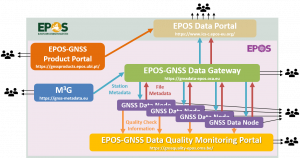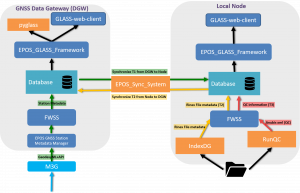a new way of accessing GNSS data and products for Solid Earth Science researchers
This page provides information about the infrastructure and the software developed to access the EPOS GNSS data and products.
The set of tools installed at the EPOS-GNSS Data Gateway, the EPOS-GNSS Product Portal and at the GNSS Data Nodes is called EPOS GLASS Package (see Figure 1).

Figure 1: GLASS Package at EPOS GNSS
EPOS GLASS Package
The Figure 2 shows the architecture of the main components of the GLASS package and the teams responsible for their maintenance.
With this set of tools, it is possible to fully manage the functionality of the nodes. It is possible to insert new metadata, visualize all the metadata of the GNSS data inserted in the database, check the quality of the data and synchronize station and file metadata between thh different components. This set of tools is available on gitlab https://gitlab.com/gpseurope.
- The Database schema is necessary for storing all GNSS station and file metadata – (UBI)
- IndexGD allows to index the metadata of the GNSS observation (RINEX) files – (OCA)
- FWSS is an API for inserting metadata for the GNSS stations, the RINEX files and the quality indicators in the database – (INGV)
- EPOS Glass Framework is an API that serves the metadata stored in the database – (UBI)
- RunQC allows to check the quality of the GNSS data using Anubis software (developed by GOP) – (ROB)
- Synchronization system allows to synchronize metadata between nodes and DGW – (UBI)
- GLASS web client is the GUI used by the DGW and the nodes to explore the metadata – (OCA)
- pyglass is a command line client allowing to retrieve station metadata, RINEX file metadata and download the RINEX files – (OCA)

Figure 2: Components of the GLASS Package